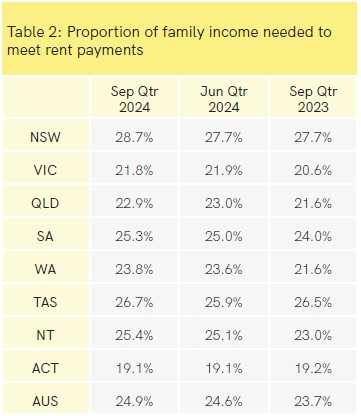WA has recorded its smallest decline in housing and rental affordability since the September 2023 quarter, according to the latest Real Estate Institute of Australia (REIA) Housing Affordability Report.
Both housing and rental affordability decreased by just 0.2 percentage points in the September 2024 quarter.
REIWA CEO Cath Hart said several factors contributed to this change.
“WA recorded an increase in median weekly income over the quarter and this has helped offset increases to loan size and rent payments,” she said.
“In addition, the rate of house price growth has been slowing, which has seen the average mortgage increase by just 1.2 per cent over the quarter, and rent prices are showing periods of stability. These changes have also helped slow the decline in affordability.”
Housing affordability
The proportion of family income required to meet monthly loan repayments in WA increased 0.2 percentage points to 39.8 per cent in the September 2024 quarter.
This was based on a median weekly family income of $2,646 and average monthly loan repayment of $4,566.
This compares to increases of 1.7 percentage points in the June 2024 quarter, 1 percentage point in the March 2024 quarter and 2.2 percentage points in the December 2023 quarter.
WA remained the most affordable state for home owners in the September quarter. Only the ACT (34.7 per cent of family income) and the Northern Territory (31.6 per cent) were more affordable.
New South Wales remained the least affordable state, with home owners requiring 58.1 per cent of family income to meet loan repayments.

Loan activity
Ms Hart said loan activity in WA showed mixed results, with a decline in new loans over the quarter but an increase compared to the same time last year.
“The total number of new loans to owner occupiers in WA decreased 6.4 per cent over the three months to September to 10,114, but increased 6.9 per cent over the year,” she said.
“The average loan size in WA was $554,459 in the September quarter, up 1.3 per cent from the June quarter. It was 16.9 per cent higher than the September 2023 quarter, reflecting strong price growth over this time.”
First home buyers were also less active in the September quarter.
“The total number of loans to first home buyers decreased 10.2 per cent over the quarter to 3,713. However, this is 1.8 per cent higher than the September 2023 quarter,” Ms Hart said.
“The average loan to first home buyers was $482,359, up 1.5 per cent quarterly and 14.9 per cent annually.
“Despite rising prices, WA is one of the most affordable states for first home buyers, with only the Northern Territory ($421,935) and Tasmania ($421,063) more affordable.”
Rental affordability
The proportion of family income needed to meet rent repayments in WA rose 0.2 percentage points over the quarter to 23.8 per cent. This compares to increases of 0.6 percentage points in the June and March quarters, and 0.9 percentage points in the December 2023 quarter.
Ms Hart said the low decline in affordability reflected the changes in the rental market over the past year.
“The pressure in the Perth rental market has been easing over 2024,” she said.
“We’ve seen new supply come to the market, which has seen the vacancy rate increase and rent prices record periods of stability.”
Nationally, WA was in the middle of the pack for rental affordability, with the ACT (19.1 per cent of family income), Victoria (21.8 per cent) and Queensland (22.9 per cent) more affordable.
New South Wales remained the least affordable for tenants, with 28.8 per cent of family income required to meet rent payments. It also recorded the largest quarterly decline in affordability, with a 1.0 percentage point increase in the proportion of family income needed to meet rent repayments.
Rental affordability improved slightly in Victoria and Queensland over the quarter, remained stable in the ACT, and declined in all other states and territories.



